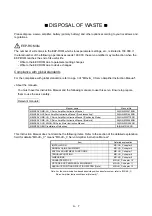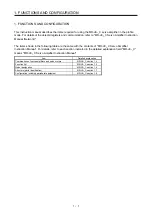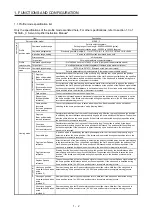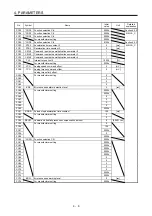
2. SIGNALS AND WIRING
2 - 3
2.1 I/O signal connection example
Servo amplifier
26
(Note 2)
Malfunction (Note 6)
Encoder Z-phase pulse
(open collector)
Encoder A-phase pulse
(differential line driver)
17
DOCOM
15
ALM
11
LA
24
LAR
12
LB
25
LBR
23
LG
SD
10 m or less
Encoder B-phase pulse
(differential line driver)
Control common
CN3
22
INP
In-position
Encoder Z-phase pulse
(differential line driver)
13
LZ
LZR
CN3
5
DICOM
Plate
1
3
2
4
Forced stop2 (Note 3)
Proximity dog
Touch probe 1
Forward rotation
stroke end
Reverse rotation
stroke end
EM2
LSP
LSN
DOG
RA3
(Note 8)
Power supply
24 V DC
(Note 4, 11)
10 m or less
24 V DC (Note 4, 11)
6
(Note 15)
TPR1
18
(Note 15)
OPC
(Note 5)
(Note 9)
16
OP
RA1
RA2
(Note 1)
+
USB cable
(option)
(Note 7)
MR Configurator2
CN5
CN1
CN6
Personal
computer
Ethernet cable
Switching
hub
Modbus RTU
(Note 10, 12, 13)
CC-Link IE Field Network
Basic, SLMP or Modbus/
TCP
(Note 10, 12, 13)
(Note 14)
Note 1. To prevent an electric shock, be sure to connect the protective earth (PE) terminal (marked ) of the servo amplifier to the
protective earth (PE) of the cabinet.
2. Connect the diode in the correct direction. If it is connected reversely, the servo amplifier will malfunction and will not output
signals, disabling EM2 (Forced stop 2) and other protective circuits.
3. The forced stop switch (normally closed contact) must be installed.
4. Supply 24 V DC ± 10% to interfaces from outside. The total current capacity of these power supplies must be 300 mA or lower.
300 mA is the value applicable when all I/O signals are used. The current capacity can be decreased by reducing the number
of I/O points. Refer to section 3.9.2 (1) of "MR-JE-_C Servo Amplifier Instruction Manual" that gives the current value
necessary for the interface. The illustration of the 24 V DC power supply is divided between input signal and output signal for
convenience. However, they can be configured by one.
5. When starting operation, always turn on EM2 (Forced stop 2), LSP (Forward rotation stroke end) and LSN (Reverse rotation
stroke end) (normally closed contact).
6. ALM (Malfunction) turns on in normal alarm-free condition (normally closed contact). When this signal is switched off (at
occurrence of an alarm), the output of the programmable controller should be stopped by the sequence program.
7. Use SW1DNC-MRC2-_. MR-JE-_C Servo Amplifier Instruction Manual section 11.4
8. Configure a circuit to turn off EM2 when the power is turned off to prevent an unexpected restart of the servo amplifier.
9. You can change devices of these pins with [Pr. PD30], [Pr. PD31], [Pr. PD32], and [Pr. PD38].
10. For communication function, refer to the "MR-JE-_C Servo Amplifier Instruction Manual (Network)”.
11. This diagram shows sink I/O interface.
12. Modbus/TCP can be used on servo amplifiers with software version A3 or later. Modbus RTU can be used on servo amplifiers
with software version A4 or later.
13. Ethernet communication (CC-Link IE field network Basic, SLMP and Modbus/TCP) and RS-485 communication (Modbus RTU)
are exclusively independent functions. Only the communication function selected in [Pr. PN08] "Select communication
function" can be used.
14. If this servo amplifier is the last axis, connect a 150 Ω resistor between DA and DB, and terminate the servo amplifier. For
details, refer to the "MR-JE-_C Servo Amplifier Instruction Manual (Network)”.
15. When CN3-6 pin is used as the input device of sink interface, of 24 V DC to CN3-18 pin (OPC: power input for open-
collector sink interface).
Summary of Contents for MELSERVO-JE
Page 15: ...1 FUNCTIONS AND CONFIGURATION 1 4 MEMO ...
Page 21: ...2 SIGNALS AND WIRING 2 6 MEMO ...
Page 57: ...4 PARAMETERS 4 34 MEMO ...
Page 109: ...6 SERVO MOTOR DRIVING 6 44 MEMO ...
Page 111: ...7 APPLICATION OF FUNCTIONS 7 2 MEMO ...
Page 113: ...MEMO ...















































